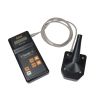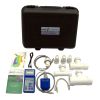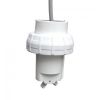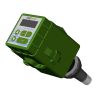Eno Scientific Well Sounder 2010 PRO Water Level Meter
Features
- Automatic temperature compensation
- Calculate drawdown and recovery rates
- Data points stored in non-volatile memory
- Free ground shipping
- Expedited repair and warranty service
- Lifetime technical support
- More
Overview
The Eno Scientific 2010 PRO is a portable sonic water level meter that uses sound waves to measure the distance from the top of the well to the water level, eliminating the need to lower anything into the well and preventing well contamination. Simply place the probe into a well cap vent opening and turn the unit on. Within seconds, the static water level measurement is displayed. With the press of a button, the instrument calculates and displays a variety of other information such as the total water in the well, rate of change, temperature, and battery voltage.
Built-in Data Logger
The Eno Scientific 2010 PRO can record up to 13,000 time-stamped readings along with the well ID, temperature, and other associated measurements. The logger can be set to take measurements automatically at intervals between 1 and 60 minutes, or manually by pressing the LOG button on the keypad. The recorded data can be reviewed on the screen or downloaded to a computer for analysis using the serial RS-232 port or the included USB cable. Stored data is formatted in simple Windows-compatible text files sorted by well ID. Data can be easily copied from the instrument onto the computer and opened with almost any common program such as Word, Excel, or Notepad.
Other Features
Includes a power save mode, which puts the unit to sleep between measurements when logging and turns the power off after a selected period of inactivity. If there are known defects in the well, such as a rock fissure, simply set the measurement range minimum and maximum to ignore the interference. The multi-purpose bi-directional serial port can also be used to transmit data in real-time to a remote readout or logging device.
- Power
- Internal Power: 6 AA Alkaline batteries
- External Power (Optional): 5.5 to 12VDC at 50ma
- Real-Time Clock: Li Ion 3V battery CR2032
- Measurement
- Resolution: .05 ft
- Accuracy: 0.1 ft
- Range: 9 to 2000 ft
- Temperature Compensation: Built-in to probe
- Logging
- Memory: Non-volatile flash memory for 13,000 data points
- Logging Rates: 1 second to 60 minutes
- Environmental
- Temperature: -10 to 110 F
- Humidity: 10 to 90% non-condensing
- Physical
- Dimensions: 4"x 7.5"x 1.25"
- Weight: ~13 oz
- Display: 2x16 character LCD
- Outputs
- USB port: For access to file system
- Serial Output: 300 to 57600 baud, 8 data bits, 1 stop bit (19200 baud default)
- (1) Well Sounder 2010 PRO meter
- (1) Probe with 6 ft cable
- (1) USB cable
- (1) Carrying case
- (1) US Groundwater Temperature Chart
- (1) Quick Start Guide
- (1) User Manual
In The News
Eno Scientific Well Sounder: The power of sound echoes water level measurements
Measuring the distance to the water’s surface in a well can be difficult, especially when the well is deep and full of obstacles that can block and entangle mechanical measuring tools. But the Eno Scientific Well Sounder 2010 Pro gets around those obstacles with the power of sound, eliminating the need for any mechanical measuring. The device sends low-frequency sound waves down a well until they hit liquid. “The sound can go around all the wiring and pipes and stabilizers within the well and give a measurement within a second,” said Rachel Bean, Eno Scientific sales manager. The Well Sounder’s probe emits broadcasts low-frequency sound waves from the top of a well. The waves return in about one second per 500 feet.
Read MoreSpring 2025 Environmental Monitor Available Now
In the Spring 2025 edition of the Environmental Monitor, we highlight partnerships across the world and the importance of collaboration between government agencies, universities, environmental groups, local communities, and other stakeholders. From great white shark research in Cape Cod to monitoring fisheries in Lake Erie, this latest edition underscores partnerships that connect stakeholders in a watershed through environmental data. With an emphasis on data sharing, a combination of real-time and discrete sampling keeps the public and partners informed of environmental conditions. Our writers also sought out science professionals dedicated to working with peers within and outside of the environmental sector.
Read MoreMonitoring Mariculture in the Gulf of Alaska
The mariculture industry in the Gulf of Alaska has been steadily growing in recent years, guided by ongoing research to help refine farm location and cultivation practices. A subset of aquaculture, mariculture focuses on rearing organisms in the open ocean. In Alaska, finfish farming is illegal, so most farms cultivate kelp, oysters, or a combination of the two. These small, locally operated farms started popping up in the Gulf of Alaska in the early 1990s, when shellfish farming first became legal. Kelp farming did not begin to catch on in the state until 2016. Many of the coastal areas that have grown interested in mariculture are historically commercial fishing communities.
Read More
















